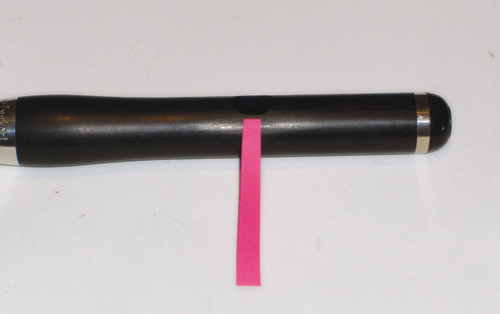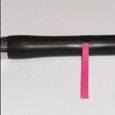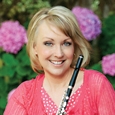Vibrato on the piccolo is produced in the same way as on the flute. It is an oscillation of the air column created in the larynx. Vibrato may be defined as a slight pitch variation within a sustained tone. You can observe this effect by playing a note with vibrato using a digital strobe tuner. The dial will show this slight fluctuation above and below the correct pitch in rhythm to the vibrato pulse.
One of the most concise explanations of vibrato is written in Mary Karen Clardy’s Flute Fundamentals Flute Fundamentals: The Building Blocks of Technique (European American Music Corporation, 1993). Clardy cites scientific studies using fiber optic cameras which capture the larynx in action and X-rays which show that the diaphragm is not moving while wind players and singers produce a tone with rich vibrato present in the sound.
I have long been envious of string pedagogy since vibrato is such a visual event with those instruments. To create a helpful visual aid for flutists, attach a strip of a post-it note to the far side of the piccolo embouchure hole.

When working on vibrato, this strip will bob with the pulse of the breath as the extra air comes across the embouchure hole, providing a bit of a visual confirmation to the concept of vibrato.
The body uses this area of the larynx when clearing the throat, crying, laughing and singing. I have always loved to teach vibrato as a connected ha, ha, ha sound. First speak the syllables, and then connect them as in singing. Next, remove the consonant h sound and continue singing. Then try all of this through the flute.
Make sure that you understand the difference between vibrato speed and vibrato width. Speed refers to how many pulses of vibrato are placed per beat. For example, most flute and piccolo players work on counted vibrato speed exercises with a metronome. Set the metronome at q = 60 and vibrate with groups of 3, 4, 5, or 6 per click. When practicing this make sure you connect the pulses evenly without a jarring bump or pulse. Listen to the evolution of vibrato speeds through different recordings. Modern musicians seem to generally favor a slower vibrato than what was in vogue at the turn of the 20th century.
Wider vibrato naturally moves at a slower speed, and conversely, faster vibrato is narrower. It is very helpful to cultivate a very shallow vibrato (just a hint of shimmer), a normal depth of vibrato, and a wider vibrato which moves throughout the depth of the tone. All three of these kinds of styles are useful on a daily basis. A deeper, slightly slower vibrato can add volume to the tone. Even though vibrato is thought to be a fluctuation of pitch, both on the high and low side, I try to keep it on the lower side so as to not raise my pitch unintentionally. It helps to end notes, or release, on the high side of the vibrato so the pitch does not sag.
Vibrato Pitfalls
There are a few things to watch out for with vibrato gone awry. Overall, vibrato must be applied with a fairly light hand. If my ears are immediately drawn to vibrato, it is often overpowering the tone. It should be a part of the tone, a shimmering inner core, within the overall sound. Take care that the vibrato is not erratic or uneven. It is possible to have a vibrato that is too wide (particularly in the low register or when playing softly) and likewise, the dreaded nanny goat vibrato is a fault as well. This kind of vibrato is produced with tight vocal chords that make the vibrato thin and wiry. Sometimes the vocal folds are so tight that there is actually a pitch occurring with the vibrato. If this is the case, separate the vocal folds by panting and try again.
Piccolo Specifics
The artistic application of vibrato on piccolo will be slightly different than on flute. In general, piccolo vibrato will be a little faster and narrower than flute vibrato. Try to listen and downsize your vibrato so it does not overpower the smaller mass of tone on this petite instrument.
Naturally, vibrato should not be intrusive on tutti passages, especially as the top voice on sustained chords, for example. I sometimes use very little vibrato on chords, which helps the blend, or choose a slower, deeper vibrato for adding just a little sonic interest. If you are playing a passage with an instrument that does not use vibrato, such as the clarinet, make sure you do not vibrate too fast or you will not achieve a good blend. Use more creative speeds and widths on solo passages.
Vibrato is traditionally not used on busy passages with many sixteenth notes as it distorts the tone and hurts projection. Dynamic levels and the resultant changes in both embouchure size and air pressure will affect vibrato speed as well. If you are playing very softly, vibrato should not be too wide, or you have placed the “heart of an elephant in a mouse” as Trevor Wye has said. Vibrato is a flexible artistic device which must constantly change depending on the requirements of the music.
Practice starting and stopping your vibrato on a dime to achieve ultimate control. With the metronome set at q = 60, play two beats of straight tone, two beats with vibrato (at varying speeds, 4 pulses, 5 pulses, 6 pulses per click) then back to two beats without vibrato.
Record your practice to hear yourself as others do. Listen to all kinds of instrumentalists and singers to develop a rich imagination of tonal possibilities for vibrato. I especially enjoy violinists and sopranos because these musicians perform also in the same tessitura as the piccolo. Stay flexible as a conductor may request a different vibrato style than what you have prepared and you should be able to instantly adjust. I have sometimes heard a conductor request no vibrato on the piccolo. Often, this is because the piccolo player is using a flute-sized vibrato (too wide) for the piccolo. If you make the vibrato narrower, you will most likely fix this problem, as rarely would you play a piccolo solo without any vibrato at all, unless for a very desolate piano dynamic.
Make sure all the other elements of good tone production are in place. This includes a flexible embouchure that focuses the air to the optimal spot on the back wall and a well-supported and fast-moving air column. Remember not to overload the piccolo with air or you will have a harsh, overblown tone quality. Some students incorrectly substitute a wide vibrato in place of a fast-moving airstream. One way to correct this is work on long tones senza vibrato to make sure these two concepts are indeed complementary but separate. Adding vibrato on a stable note is like adding the sprinkles on top of a wonderful and delicious frosted cupcake. Vibrato adds expression, aids projection, and enlivens phrases.






